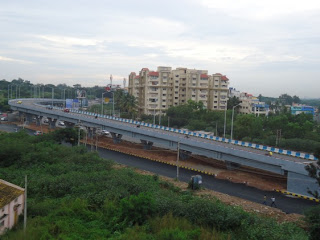
The Hoskote-Dobbespet section of NH 207 will be expanded to a four-lane highway
With BDA still to start the contentious Peripheral Ring Road,the Cabinet Committee on Infrastructure has approved the investment proposal for four-laning the Hoskote-Dobbespet section of NH 207 in Karnataka under NHDP Phase IV.
It may be noted that there was long talk of Bypass route to decongesting city.This road will act as a bypass road to Bangalore for vehicles coming from Tumkur side and heading to Doddaballapur,Hyderabad or Chennai,and vice-versa.The cost of the project will be Rs 1,153.30 crore,out which Rs 432.61 crore will be towards land acquisition,rehabilitation,resettlement and pre-construction.The total length of the project is 80.02 km.The concession period will be for 30 years,including construction period of 24 months.
The main objective of the project is to expedite the improvement of infrastructure in Karnataka and also reduce the time and cost of travel for vehicles plying between Hoskote and Dobbespet.It will also increase the employment potential for local labourers.
Meanwhile,the cabinet committee also approved the four-laning of Solapur-Bijapur section of NH 13 in Maharashtra and Karnataka at a cost of Rs 1,091.89 crore,out of which Rs 89.41 crore will be towards land acquisition,rehabilitation,resettlement and pre-construction.The total length of the project is 110.542 km.The concession period will be 20 years,including construction period of 30 months.
The main objective of the project is also to expedite the improvement of infrastructure in Maharashtra and Karnataka and also reduce the time and cost of travel for traffic plying between Solapur and Bijapur.
With BDA still to start the contentious Peripheral Ring Road,the Cabinet Committee on Infrastructure has approved the investment proposal for four-laning the Hoskote-Dobbespet section of NH 207 in Karnataka under NHDP Phase IV.
It may be noted that there was long talk of Bypass route to decongesting city.This road will act as a bypass road to Bangalore for vehicles coming from Tumkur side and heading to Doddaballapur,Hyderabad or Chennai,and vice-versa.The cost of the project will be Rs 1,153.30 crore,out which Rs 432.61 crore will be towards land acquisition,rehabilitation,resettlement and pre-construction.The total length of the project is 80.02 km.The concession period will be for 30 years,including construction period of 24 months.
The main objective of the project is to expedite the improvement of infrastructure in Karnataka and also reduce the time and cost of travel for vehicles plying between Hoskote and Dobbespet.It will also increase the employment potential for local labourers.
Meanwhile,the cabinet committee also approved the four-laning of Solapur-Bijapur section of NH 13 in Maharashtra and Karnataka at a cost of Rs 1,091.89 crore,out of which Rs 89.41 crore will be towards land acquisition,rehabilitation,resettlement and pre-construction.The total length of the project is 110.542 km.The concession period will be 20 years,including construction period of 30 months.
The main objective of the project is also to expedite the improvement of infrastructure in Maharashtra and Karnataka and also reduce the time and cost of travel for traffic plying between Solapur and Bijapur.

















